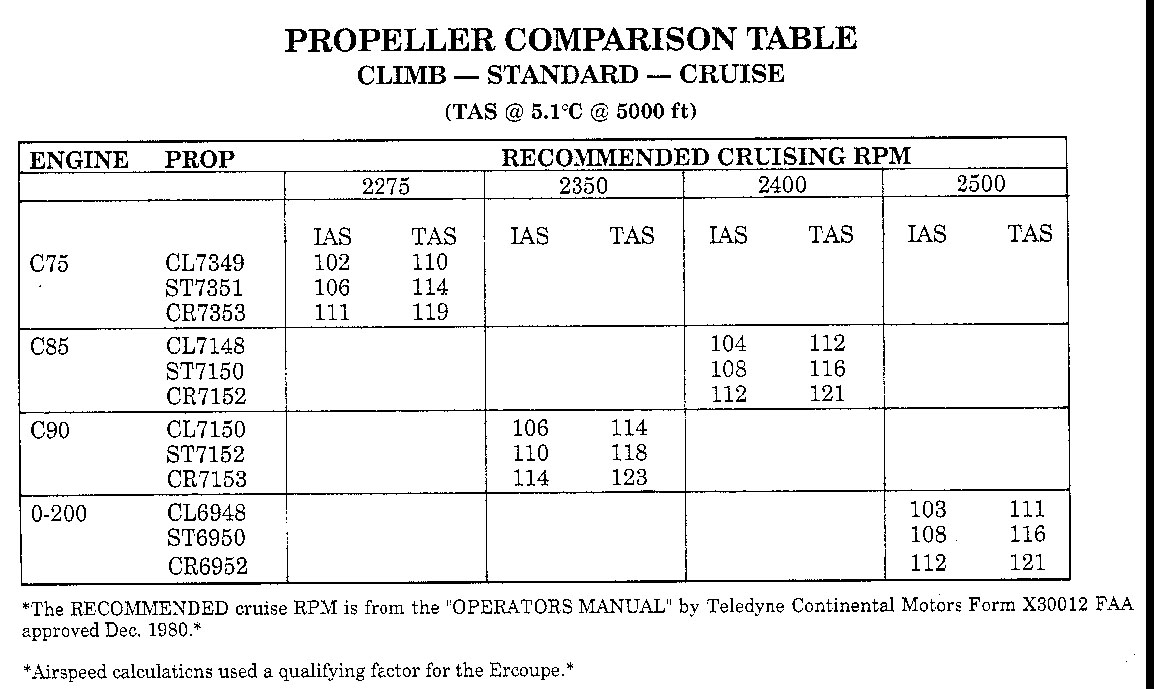Propellers for Ercoupes
|
Navigation Links |
The standard propeller that was furnished with all C-75 Ercoupes was a Sensenich 74FC48T, a wooden climb propeller.
Later on, additional propellers were allowed for this airframe & engine combination, many of them had been carried over to higher performance engines.
Surprisingly "any fixed pitch wood propeller" that falls within a static R.P.M. range of 1900 to 2050 can be used for the Continental c75/85 engine. Fifty R.P.M. additional is allowed at each end of the range to cover instrument errors and variable conditions, making the total range permissible in field operation 1850 to 2100.
Not many people use wooden propellers anymore, but recently there has been a trend to embrace wood again as a material for props. The dampening qualities of wood and the weight saved and probably the saved money also are the decision factors here.
The C-75 uses a 73-74 inch prop, while the C-85 is shorter (71-72 inches) to allow faster running. The C-90 shares the prop of the C-85 just runs slower and is using a steeper pitch therefor, while the O-200 is made to run faster and hence is fitted with even a shorter propeller.
here a list of props tested on a C-75 engine
| Propeller | Sensenich 74FC48T (Standard Equipment) | Sensenich 74FC52T | Lewis L55C 72” Dia. 49” Pitch | McCauley 1-A-9O 73” Dia. 51” Pitch |
Cruising Speed at 2275 Maximum Speed R.P.M. at Maximum Speed Max. Rate of Climb at Sea Level Take-Off dist.,Turf, Zero Wind | 103MPH 121MPH 2600 700’/min. 560 Ft. | 108MPH 120 MPH 2520 680’/min. 620 Ft. | 111 MPH 118 MPH 2420 610’/min. 600 Ft. | 109MPH 122 MPH 2500 710’/min 520 Ft. |
 |  |  |  |  |
| --- | --- | --- | --- | McCauley 1A90 Service Manual |
Not to the surprise to many, the aluminum McCauley outperformed all other propellers, even though pitched for a normal to cruise setup. It made the McCauley defacto the standard Ercoupe propeller. Here a list of the perfect combinations for a healthy engine (e.g. producing rated power and their corresponding McCauley propellers on an Ercoupe or Aircoupe.

The long and slow running propeller of the C75 gives the most economical prop/engine combination with a minor loss in performance. The C90 alows for the best performing prop/engine combination - at costs of economy though.
PROPELLER PERFORMANCE
Harry Fenton on Propellers
"The easiest way to notice more performance with a small Continental is to lighten the airframe! Lighter airframes stall slower, take off faster, climb better, cruise faster. In most cases, adding horsepower only improves rate of climb, but not much in speed. Speed gains are usually drag, rigging and weight issues."
Here something about performance from the Sensenich publications:

In selecting a propeller, keep in mind that both aircraft and engines of the same model may vary in performance, and that operators may want different performance characteristics. For instance, one person may require a high climb rate while another seeks maximum cruising efficiency.
STANDARD PITCH / NORMAL FLYING
For normal or cross country flying, a fixed
pitch propeller that turns between rated engine RPM
and 50 RPM over rated at full throttle level flight at
sea level will give best all-around performance.
CRUISE PITCH
A cruise propeller will turn 50 to 100 RPM under rated
engine RPM at full throttle level flight. While cruise
pitches will provide 4-6 mph higher airspeeds at
cruise power rpm’s, maximum level flight speeds are
no better than climb or standard pitches, and the
take-off and climb performance will noticeably suffer.
CLIMB PITCH / HIGH ALTITUDE OPERATION
For improved take-off and climb
performance, use a climb pitch propeller that will turn
100 to 150 RPM over rated engine RPM at full throttle
level flight (refer to your particular aircraft Type
Certificate for propeller limitations). Climb pitches will
typically reduce flight speeds by 4-6 mph at cruise
power RPM’s. A climb pitch is also recommended for
aircraft operating from high density altitude runways.
And here another article about torque versus rpm and the right propeller to use: Torque versus RPM
Bob Sanders about Propeller Performance Sanders & Prop Performance